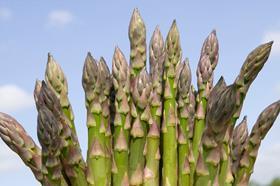
Asparagus is in season in more ways than one. With the harvest underway, growers have enjoyed a good start to the season compared to last year, where cold weather delayed cropping. The versatile vegetable is also enjoying big uptake from consumers, who are responding to efforts to show off its cooking repertoire.
The season begins every year with a chuckle on 23 April, with the traditional fanfare of Gus the Asparagus Man delivering the first batch of asparagus from the Vale of Evesham. Laughter aside though, asparagus is posting some serious business results. According to Kantar data the category has been one of the top performers in penetration over the past year, seeing massive volume growth in excess of 30 per cent and 17 per cent value.
Wealmoor’s Per Hogberg says: “As we enter the 2019 UK season we see a fundamental increase in volume as consumer demand grows. Over two thirds of shoppers are actively looking for British asparagus and that figure is significantly higher compared to other speciality vegetables.”
Bundles continue to be the mainstay in terms of volume but the growth has come from tips and fine over the last few years as consumers buy into the convenient ready-to-cook side-of-plate element that this assortment offers.
On the back of this growth Wealmoor is launching a new asparagus brand, Saxon’s Asparagus. “We firmly believe and are wholeheartedly committed to growing the asparagus category across a multitude of market channels and have as such invested in extensive production in Suffolk. Our growing partnerships in other parts of the country have also continued to expand,” says Hogberg.
“The focus on foodservice, B2B and wholesale led us to launching Saxon’s Asparagus, a brand that we believe is the perfect vehicle to deliver growth in these sectors – currently brands in the sector are farm-based and in most cases regionally focussed.”
Growers like Andy Allen, who sells under the Portwood Asparagus brand, recognises that optimism. “I think it’s great that a lot of the foodies and chefs are getting behind it; the British crop is obviously fresher than anything brought in from far away.” He says one of the main targets for UK growers is gaining market share from imports. “I think there’s still potential for the crop, we’re still importing asparagus during the UK season and as growers we would like to pick up some of that.”
The new-found belief in asparagus at the moment was not a given, however, as the category has struggled in recent years from basic economic hardships. One grower who supplies locally, Paul Haydon from First Gras, says he won’t be planting any more in his greenhouse. “When we started with early asparagus no one else was growing early in walk-ins. At the start we could get a good price, but there’s too much competition about.
“We wont be planting any more asparagus. It’s an expensive crop to produce and to harvest each one has to be cut individually by hand. There will be UK growers as long as there is demand for UK asparagus and there is a premium price, but I’m not sure the premium is a price that makes it worth doing. I wouldn’t want to be planting any more volumes now.”
Hogberg notes that asparagus “is a slow burn in terms of a return on investment”. He continues: “We have seen the number of growers in the UK decline as cost pressures and poor returns have led to a few growers turning to alternative crops in their search for viable returns, with many not renewing crowns as 10-year crop cycles come to an end,” says Hogberg.
For Wealmoor, the category could take a leaf from other fresh produce success stories such as berries, which have won favour with customers by expanding their capacity. “The key to increasing crop profitability centres around season extension from open-field growing as opposed to covered production, both of which have a role and the use of early and later cropping varieties continues at pace and must be seen as the way to improve returns,” Hogberg says.
Allen notes that polythene-covered asparagus crops are hard to justify however. “You can’t extend the season much longer. There’s a limited market for growing under polythene as it’s too expensive.”
Despite the increased popularity of asparagus in the UK, a short hop across the channel shows how western Europe boasts an asparagus market with bigger spears and higher penetration, as well as more varieties. For Hogberg, it’s something that the UK might take a while to catch up with.
“Value is being added through the introduction of white and crimson varieties and these are appearing in pockets in retail but have yet to make it into the mainstream. In April we took a delivery of our first crop of crimson asparagus and will have some white available next week or so. However, it’s fair to say that we have a long way to go when it comes to catching up the trends in Germany and France.”






No comments yet